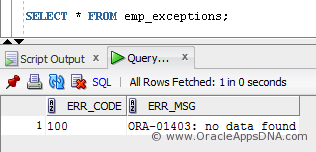Yes! We all know that cannot use SQLCODE, SQLERRM in INSERT Statement! but why??
SQLCODE, SQLERRM are predefined functions which are useful in Exception handling. We can capture error code and error message from these functions in exceptions for a some piece of PL/SQL code.
Let’s see what happens if we try to use SQLCODE, SQLERRM in INSERT Statement.
Create EMP and EMP_EXCEPTIONS tables using below table creation scripts:
--Creation of EMP Table CREATE TABLE emp ( empno NUMBER(4) NOT NULL, ename VARCHAR2(10), job VARCHAR2(9), mgr NUMBER(4), hiredate DATE, sal NUMBER(7, 2), comm NUMBER(7, 2), deptno NUMBER(2) ); --Creation of EMP_EXCEPTIONS table CREATE TABLE emp_exceptions ( err_code VARCHAR2(20), err_msg VARCHAR2(2000) ); |
Run the below PL/SQL block of code which tries to find information of empno 1000, but here EMP table is empty since we dint insert any records, so ideally this block of code should through no data found error.
DECLARE name emp.ename%TYPE; v_code NUMBER; v_errm VARCHAR2(64); BEGIN SELECT ename INTO name FROM emp WHERE empno = 1000; EXCEPTION WHEN OTHERS THEN INSERT INTO emp_exceptions (err_code,err_msg ) VALUES (SQLCODE,sqlerrm ); COMMIT; END; / |
After running the above pl/sql code we can observer below error message since we are directly using SQLCODE and SQLERRM in INSERT statement.
Error report:
ORA-06550: line 14, column 14:
PL/SQL: ORA-00984: column not allowed here
ORA-06550: line 11, column 3:
PL/SQL: SQL Statement ignored
06550. 00000 – “line %s, column %s:\n%s”
*Cause: Usually a PL/SQL compilation error.
*Action:
Why is the error coming
The purpose of above PL/SQL code is to capture the error information which occurred in a previous SQL statement into some table using SQLCODE and SQLERRM in INSERT statement. But what if the INSERT statement itself FAILS? then how will SQLCODE and SQLERRM information will be captured for both previous SQL statement and current INSERT statement? food for thought?? Yes! Ideally we can capture only one set of Error information using SQLCODE and SQLERRM, its not possible to capture both the error information that is the reason we CANNOT use SQLCODE and SQLERRM in INSERT statement.
Solution
we have to assign them to a variable and use the variables in INSERT statement as shown below.
DECLARE name emp.ename%TYPE; v_code NUMBER; v_errm VARCHAR2(64); BEGIN SELECT ename INTO name FROM emp WHERE empno = 1000; EXCEPTION WHEN OTHERS THEN v_code := SQLCODE; v_errm := SUBSTR(sqlerrm, 1 , 64); INSERT INTO emp_exceptions (err_code,err_msg ) VALUES (v_code,v_errm ); COMMIT; END; / |
